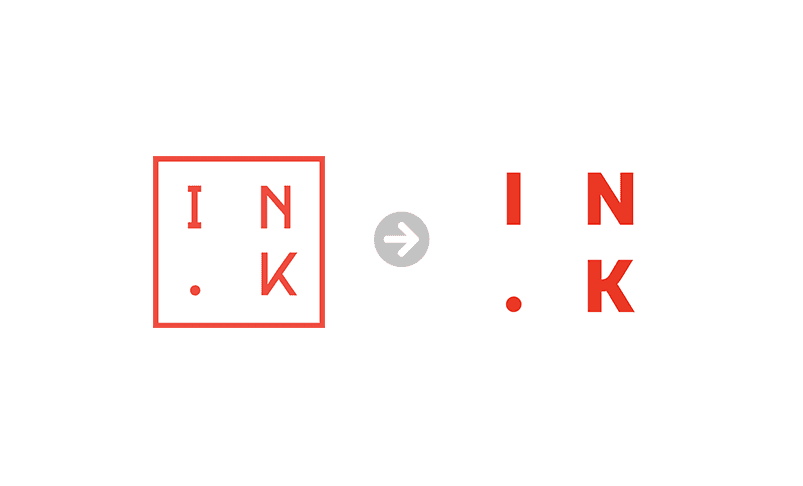Recently we have renewed ourselves by crystalizing our vision, mission, values and work principles.
After communicating it inside the company, we knew that the next logical step would be to rebrand ourselves in order to communicate these changes to the outside public. Since this process came packed with interesting discoveries, I decided to share this experience.
So when should you rebrand through updating your brand and when should you start from scratch? Where should you start and what mistakes should you avoid? I’ll put my thoughts on the recent INK rebranding here with the insight of Indrė Baltušė and Aistė Jakimavičiūtė-Bikauskė providing the respective strategy insight and visual development at the brand identity agency Imagine.


When turning to brand experts who were to renew our brand we presented them with our strategy. We described integration in communication as a given. We understand that this dynamic sphere has far outgrown the public relations from which the company initially sprang from as far as our clients’ needs are concerned. We focus on solving our clients’ problems by finding the perfect tools for the job while working with our clients towards their victories. How did you formulate the goals for the brand as an identity agency?
I.B.: Usually when creating or updating a brand we use the company’s strategy as the brand strategy. In this particular case we did just that, we tried to represent your renewed strategy and the integrated client based problem solving.
The insight we centered on when creating the brand strategy was the changed reality of the digital world. Nowadays a digital representation of a brand is no longer just nice to have, something that you have to come up with a separate digital solution for. Nowadays the digital sphere it is the first touchpoint with a company’s brand. With that in mind, when working on the new INK brand we put its digital adaptability as the prime goal.
A.J-B.: When creating the graphic language, the business specifics played a key role. Lots of text which is difficult to show visually. That being said, it is important that the brand would be easily noticed in the digital sphere, now dominated with visuals. Because of this, we focused on a rich and dynamic graphic language with a lot of color, details and specific hierarchy that would further emphasize the content itself.
By translating the company’s strategy into the brand strategy, we visualized it in the new logo, while the graphic language was based around presenting colorful and dynamic content.
We wanted to emphasize that it wasn’t a revolution, but rather an evolution of the brand. Because of this, the logo wasn’t changed significantly and was merely made more digital-friendly.
Aside from the renewed strategy, which we wanted to be visualized, we had other more mundane needs. Specifically, to modernize our old templates and to put more emphasis on the seven year running blog that is co-authored by the entire staff. We have been talking about rejuvenating it for quite some time, but didn’t want to tackle our brand and graphic language before completely ironing our business strategy out. It would be interesting to hear what you think is not a good reason for a rebranding. What are the common mistakes companies make when they decide to rebrand?
I.B: There are a lot of brands out there that span tens of years without losing their relevancy. The mere aging of the visual language is not a good enough reason for change. Sometimes when you want to renew your templates or internet site, a full rebranding might not be needed, some fresh details might be enough.
A.J-B.: One of the most common mistakes is to beeline towards the final means and the visuals while ignoring the strategy. Without a solid strategy picking the right means towards the end is hard if not impossible and furthermore, it is extremely difficult to judge the new solutions since the criteria on which to judge them is not made apparent. In such cases personal aesthetic taste and emotions take hold, which is the biggest possible mistake to make when creating a brand.
Is it possible to tell when a company is in need of rebranding? What are the tell-tale signs that it is time for a facelift?
A.J-B.: There is no one-fits-all solution. Every business and brand situation is individual and unique, it needs authentic solutions, depending on specific goals, strategies, service packages and the team itself.
It is a prevailing myth that a brand needs to undergo scheduled changes every X years. The brand must be updated when changes occur in business strategy, brand positioning, services or products, uniqueness, etc. Alternatively, the changes can happen in the brand environment itself, the habits of consumption, or the channels that the brand has to dynamically react to in order to stay relevant.
I.B.: There are companies that thrive with brands that have been untouched for a hundred years. For example, Mars is currently in the works on updating their brand and this was a decision that came about after years of internal discussions on what Mars is today.
To summarize, brand renewal can come about for a number of reasons, which are individual to every business. These can be internal changes, a dramatically changed environment, even dated templates. However, the most important thing is to tread carefully, taking into account the visual identity of the competitive environment and carefully avoiding similarities. If a B2C brand is being created, it should be done even more cautiously, as consumers are usually accustomed to recognizable brand specifics and therefore more sensitive to visual changes than the B2B sector.
The INK brand had no negative associations with it, it was recognizable thus we didn’t want to completely overhaul it. When should you change the brand completely and when is an update enough?
I.B.: Speaking of this specific case, we consciously chose the path of evolution over revolution. This brand was well known before the upgrade, had formed some positive associations, which is very important. However, the business strategy and the portfolio of services have gradually changed. Thus, in a changing environment it was necessary to find a way to properly express excellence and create a modern, dynamic image with an existing visual identity.
In general, we view brand building through a strategic prism. Therefore, in each case, even if we work with a well-established, well-known brand of twenty years, we first analyze its business and try to understand the specifics of the services it provides, the established relationship with the target audience. Only then will we decide on how much can be changed visually.
For example, there are cases where the brand looks horrible, but has an extremely strong position with the consumer, is well known, the consumer buys it impulsively because of simply loving the product. In such cases, even if we want to completely scrap the concept, we can’t. In such cases we then normally plan a step by step gradual upgrade schedule, where in a couple of years, we introduce small gradual changes in increments that consumers hardly notice.
As mentioned before, we arrived to the conclusion that we want to upgrade our brand after we crystalized our brand strategy and how we wanted to introduce it externally. What is the process of creating or upgrading a brand? What should be the first step after deciding on an update?
I.B: After receiving a client’s business strategy, we always strive to understand it as well as understand the specifics of the business itself and then convert it into brand strategy. After it is approved, we focus on crystalizing keywords and once those are agreed upon, we start working on visual solutions.
Of course, you can skip the strategic part, but in that case we will only provide the logo and visual elements, but it will remain unclear as to what impact they will have on the target audiences. Therefore, when creating or renewing a brand, you need to be very aware that it is not done for you, but for the customers. They are the ones that need to understand you better in order for them to act the way you want them to.
Here in INK we are used to including as many team members as we can into decision making process, as it makes the team more eager to accept changes when they feel they had a say in them. However, it is important to have one or a few key decision makers that can say the final word once everyone made their say. During the rebranding process we were also collecting feedback from the team. Do you think it is important to include more team members into the rebranding process?
A.J-B.: I agree that it is important to involve the team into it, but it is important to have one person as the final decision maker. This alleviates the risk of moving away from the brand strategy and giving into emotional solutions, which usually turn into This is Pretty/This is Ugly kind of discussions and can derail the process from the target at hand.
When choosing who to give our brand over to for the overhaul, one of the main criterions for us was knowledge of business specifics, which would allow us to save time. A reliable team, which we had worked with on many successful projects before, was also an important note as well as a one stop shop for everything from design of any needed tools to our internet site. What else should people look for in a company dealing with brand design?
A.J-B.: First and foremost, the team’s experience in the field of branding should be taken into account. It is important that the experience would not be solely based on the knowledge of visuals, but also on the understanding of brand strategy and positioning, so that high qualify for renewal or branding could be achieved.
Secondly, a modern understanding of branding is important. It is not limited to graphical solutions, but offers a wide range of branding opportunities and application in different media. Finally, team versatility should also play into the decision making. The agency must be able to create a branding system that is easy to adapt to future possible change in brand context, with new channels propping up and new campaigns being planned.